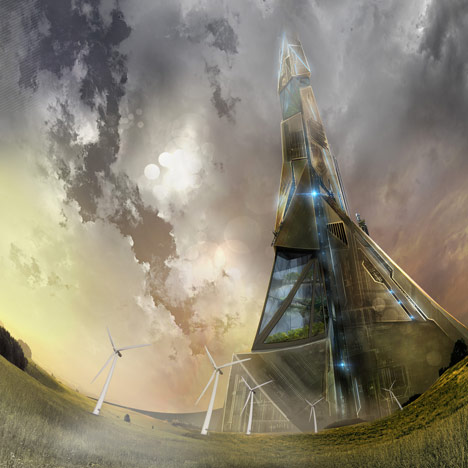News: science-fiction author Neal Stephenson is developing a concept for a 20-kilometre (12.4-mile) skyscraper that could be used to launch rockets into space.
Working alongside scientists and engineers from Arizona State University's Center for Science and the Imagination, Stephenson is exploring the limits of tall building construction using materials that are already in existence.
The author, who studied physics before moving into science-fiction, says that high-grade steel could one day be used to build a tower that is around 24 times as tall as the 830-metre Burj Khalifa - currently the tallest man-made structure in the world - and near double the height flown by most commercial aeroplanes.
"It ends up being all about wind," he told the BBC. "In a windless environment making a structure that tall would almost be trivial. But when you build something that is going to poke up through and get hit by the jet stream from time to time, then it becomes shockingly much more difficult."
Stephenson and ASU structural engineer Keith Hjelmstad are now looking at where a building like this could be located and whether it is possible to address the problems caused by wind pressure. If so, Stephenson claims its height could make it the cheapest way to send objects into outer space.
"The future of space travel, at this writing, is up for grabs with NASA eyeing destinations more distant than the International Space Station and commercial space travel just starting to get some traction," writes Hjelmstad in an accompanying research paper. "It is an interesting time to consider ideas like the Tall Tower."
The Tall Building project is a strand of Project Hieroglyph, a research programme bringing various science-fiction writers together with scientists to develop ambitions for the future. Inspired by papers written by author and scientist Geoffrey Landis, Stephenson began his project with the question: "How tall can we build something?"
"The idea of the project in general is to come up with innovations or ideas... sufficiently near-term and doable that a person sort of graduating from university today could say, 'Well, if I began working on this now, then by the time I retire it might exist'," he said.
Here's an introductory movie from Project Hieroglyph:
The Burj Khalifa became the world's tallest building in 2010, but is set to be overtaken by the Kingdom Tower, currently under construction in Jeddah and designed with a height of 1000 metres. A report published in 2011 predicts what the tallest buildings will be in 2020.
Top image by Utkarsh Kumar, Violet Whitney and Vineet Bhosle.
Here's some extra information from the project team:
The Tall Tower
The Tall Tower project is part of Project Hieroglyph, headquartered at the Center for Science and the Imagination at Arizona State University. Hieroglyph teams up top science fiction writers (including Neal Stephenson, Cory Doctorow, Bruce Sterling and Madeline Ashby) with scientists and engineers to imagine a near future radically changed by technological innovation. The project is designed to reignite our grand ambitions for the future and to inspire scientists, engineers and students to think big about the projects they pursue during their careers. The first Hieroglyph anthology, co-edited by Ed Finn and Kathryn Cramer, will be published by HarperCollins in late 2014.
The Tall Tower project began with Neal Stephenson asking a simple question: how tall can we build something? (The question was inspired by papers on the subject written by hard science fiction author and scientist Geoffrey Landis.) As he started working with structural engineer Keith Hjelmstad of ASU's School of Sustainable Engineering and the Built Environment, it became clear that it might be possible to build a very large structure – up to 20km tall – using high-grade steel. Keith developed some simple models to explore the structural requirements of such a tower and Neal began thinking about where such a building might be placed.
As the tower conversation continues, the circle of collaborators has expanded to include aerospace engineering, sophisticated digital modelling and architectural design. In a sure sign that the tower project is about to get excitingly weird, Bruce Sterling wants in. In the months to come the tower project will continue to serve as a pilot for the larger ideal of Hieroglyph: a freewheeling conversation about a radically ambitious project that could be accomplished within the next few decades. An original story about the Tall Tower, written by Stephenson and titled "Atmosphæra Incognita," will be featured in the Hieroglyph anthology.

